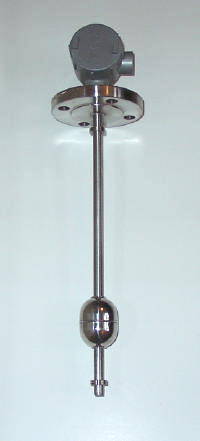 Continuous Level Transducer is available in many configurations and material. Level indication is provided by a sealed internal pc board configured to sense the magnetic lines of flux emitting from the magnet equipped float as it follows the fluid level. Continuous Level Transducer is available in many configurations and material. Level indication is provided by a sealed internal pc board configured to sense the magnetic lines of flux emitting from the magnet equipped float as it follows the fluid level.
As well as sensing high fluid levels - floats can be configured with optional specific gravities to determine levels or the interface of other fluids such as hydrocarbons on water.
Floats also can be ordered in custom sizes - from
1 1/2" to 8" for example. Sensor lengths can be 19'.
 Continuous Level Probe file pdf
Continuous Level Probe file pdf
How Does It Work?
The transducer probe encapsulates a tiny printed circuit board isolated from the probe wall and is sealed at the top preventing moisture from entering the assembly.
As the magnetic equipped float travels the probe (following the liquid level) it taps off sections of the probe thus outputting a signal that is calibrated to equal the level.
Output can be resistive with 1 to 10 VDC, or a 4 – 20 output for other types of controls. It can control a local level meter, bar graph, adjustable start stop level or pump control, alarms, chart recorders, be directed to a web and more.
Features
-
The SRC series is not limited to the spec sheet.
-
Standard lengths in stainless to 10 feet
-
Brass to 11.5 feet
-
Special request sp.gr. floats for hydrocarbons etc.
-
Several outputs available 0 to 5 VDC, 0 to 10 VDC, 4-20 mA
-
Local or remote readings – analog or digital
-
Probe size can be 0.50”, 0.625”, 1”, 1.25” tube
-
Many process connection options
-
Complete controls are available – some not shown
-
Sensing voltage – 20 VDC Max
-
Custom lead lengths
Easy Ordering
-
Select, compatible to process, transducer material
-
Choose process connection size 2” NPT and up or ½” NPT
-
Select transducer indicating length
-
Select probe length -2” required above and below transducer for float to fit. ½” diameter is most cost effective
-
Select output
-
Call or send a sketch and a drawing will be returned for approval
|

 Continuous Level Transducer is available in many configurations and material. Level indication is provided by a sealed internal pc board configured to sense the magnetic lines of flux emitting from the magnet equipped float as it follows the fluid level.
Continuous Level Transducer is available in many configurations and material. Level indication is provided by a sealed internal pc board configured to sense the magnetic lines of flux emitting from the magnet equipped float as it follows the fluid level.